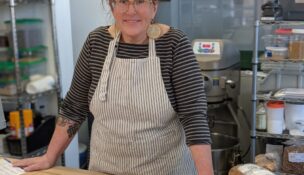Small biz: Damon Carson—a man with a repurpose
Mike Taylor //November 1, 2011//
Damon Carson shops for clothes at thrift stores, spends Saturday mornings hitting garage sales and drives a Chevy pickup with 230,000 miles on it.
Not that he has to. Carson was still in his early 20s when he and a business partner launched a waste-hauling business in Breckenridge. They sold it to Waste Management in 2001 for somewhere in the “low single millions.”
About a year ago Carson created a business called Repurposed Materials Inc., the idea being to take products deemed useless by one industry and find a buyer – a new purpose – for the goods in another industry.
“Hauling garbage all the time, I knew what gets thrown away,” says Carson, 40, who also owns Kiddie Rides USA, a restorer of vintage coin-operated rides for kids. “So this is my second foray into the waste stream of America.”
It started with vinyl billboard signage discarded by advertisers. Carson took the 14-foot-by-48-foot sheets with fading ads for Budweiser beer and the like and sold them to farmers on the Eastern Plains to use as tarps to cover hay. Soon Carson was scouring the country for old billboard signage to keep up with the demand.
Why stop with vinyl billboard signage? Carson thought. Repurposed Materials Inc. was born.
A year later at his 7,000-square-foot warehouse and rented lot near Colorado Boulevard and 38th Avenue, his inventory includes old street-sweeper brushes that ranchers are buying to use as scratching posts for horses and cattle; wine barrels from the Napa Valley repurposed as trash cans or decorative planting pots; rubber conveyor belts from coal mines repurposed as flooring for home gyms and padding for the walls of horse stalls; used roofing membrane from the Denver Mint repurposed as pond liners or other roofs; snow-break fencing from Wyoming sold as perfectly good, worn lumber. And much, much more, as they say.
Not everything Carson acquires ends up having a purpose somewhere else. He readily accepts his miscalculations. Three giant fiberglass dishes that were once perched atop cell-phone towers are a case in point.
“I thought, ‘Well, that’s interesting enough,'” Carson says. “Maybe somebody will want one as a pond liner. Or you can flip it over and have a roof for a gazebo or something.” Carson shakes his head. “Some things … there’s just not a market for them. You just try.”
In its first full year, Repurposed Materials connected with enough buyers to generate $150,000 in revenue, Carson says. He’s hoping for sales of $750,000 to $1 million in year two. His staff of five full-time equivalent employees includes Diane Seaman, whom Carson hired in July and gave the job title “chief conversationalist.”
Seaman’s first task was to converse with the sustainability departments of the largest 100 U.S. cities.
“I let them know what we do and how we can be a resource for their waste that they don’t know what to do with,” says Seaman, who spent 21 years as a “home-school mom” before returning to the work force three years ago. Next she’s calling recycling organizations and – turning to the company’s supplier role – the National Cattleman’s Association and landscaping organizations.
Carson drives me in his pickup to show me some more inventory at the lot he rents about a mile from his office and warehouse. Among the items are giant tires at least 8 feet in diameter from mining trucks that can be cut in half and used as water troughs for cattle. He marvels at how perfect they are for this repurpose: indestructible because they’re rubber reinforced with steel, and the water they hold will resist freezing because they’re black and thus absorb heat.
Carson figures it’s up to the customer whether the allure of a product is mostly environmental or economical. For most, he figures it’s the latter, and that was the case for Cam Fraser, a potential customer roaming the lot looking for materials for a greenhouse.
“Value is my main purpose, says Fraser, who had his eye on some rigid insulation panels to use on his greenhouse and possibly his garage.
Carson clearly finds great purpose in not only keeping materials out of landfills – 100 tons so far, he estimates – but doing recycling one step better from an ecological standpoint.
“In recycling plastics, newspaper, cardboard or whatever, it has to be ground, melted or chopped, and then it becomes feedstock and it gets made into something else,” he says, pointing out the energy and resources this requires. “We’re focused on reuse. Does repurposing make more sense environmentally or economically? It makes a lot of sense both ways.”
{pagebreak:Page 1}
























